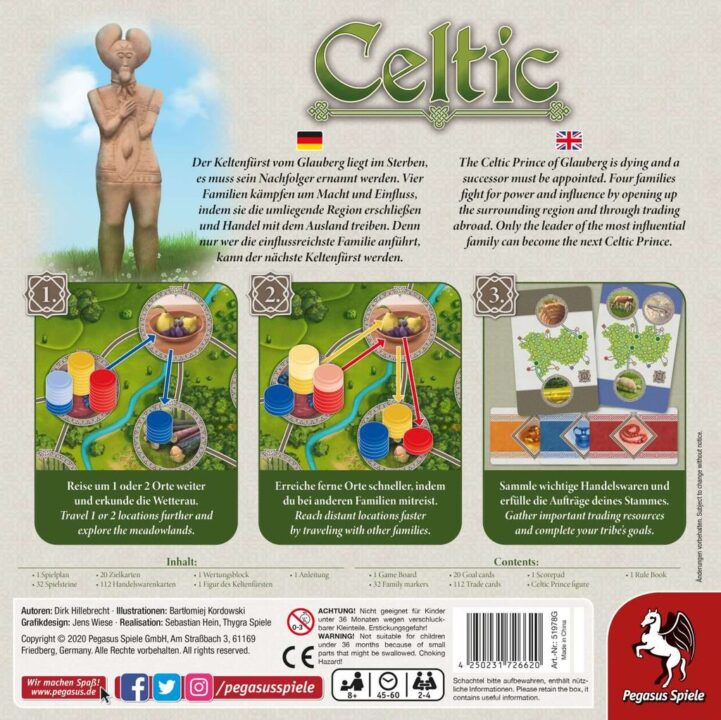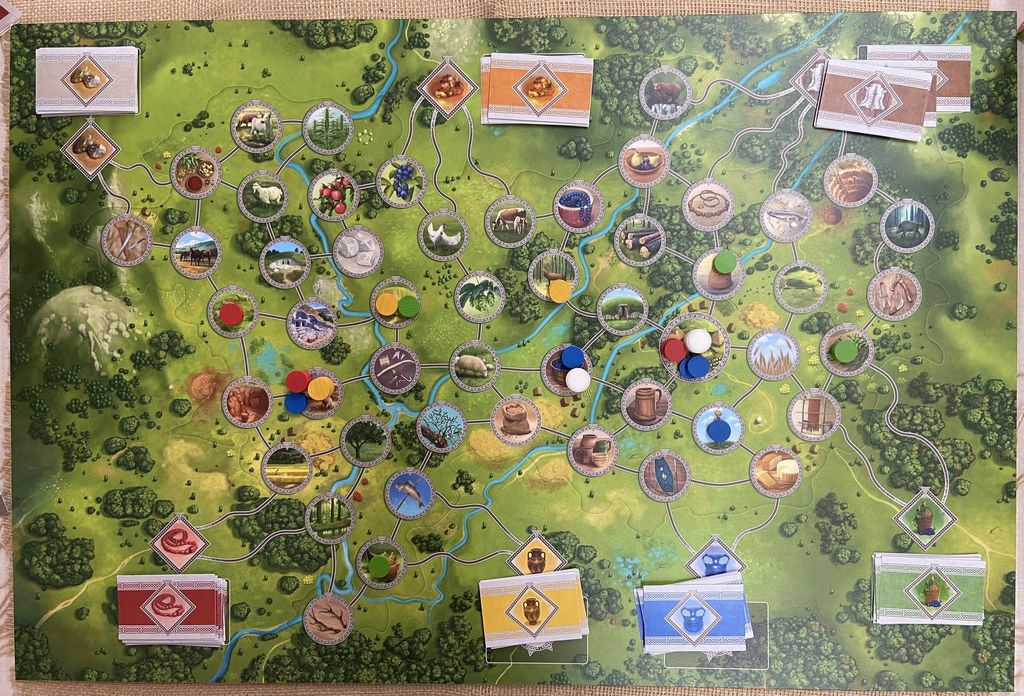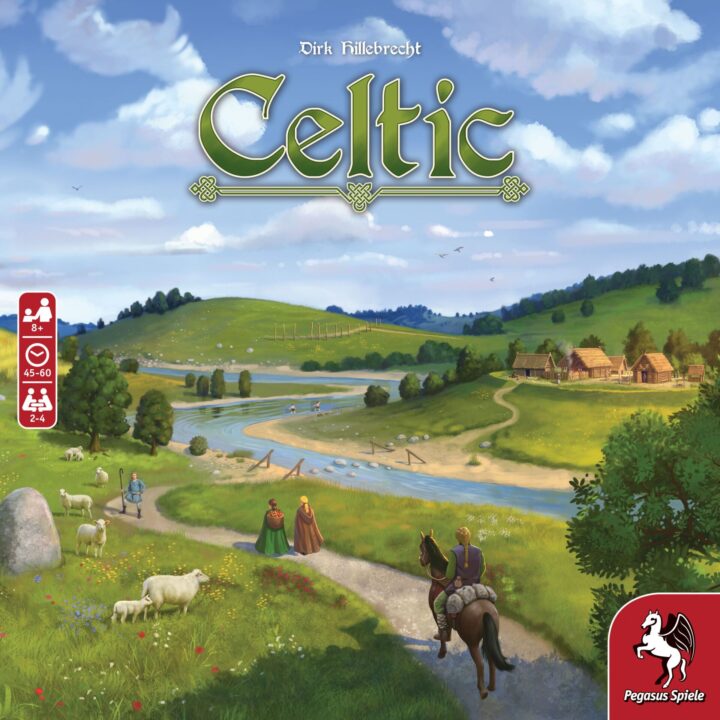Ready to set off on a path full of twists, strategy, and a little bit of mischief? Welcome to my review of a board game that had my friends side-eyeing each other harder than at our last potluck. I gathered my most competitive pals and we gave this one a proper workout. Get ready for the honest lowdown, some laughs, and maybe a painful memory of losing by one point.
How It Plays
Setting Up
First, spread out the lovely Celtic board on your table, shoo your cat away, and give each player their matching colored family tokens. Shuffle the route cards and action tiles, then lay them in their cozy spots. Everyone grabs some resources and a mission card. No need for a PhD—setup takes less time than explaining Uno to your grandma.
Gameplay
On your turn, you move your family along the winding Celtic roads, choosing to pick up resources, complete missions, or sneakily follow other players’ moves (imitation is the sincerest form of flattery, right?). Watch out for those sneaky neighbors! You gather and trade goods, fulfill missions, and try not to shout at someone blocking your shortcut. Celtic moves fast, so even your most impatient friend won’t complain (much).
Winning the Game
After the final round, everyone counts up their mission points and leftover resources. Whoever has the most points wins! If you don’t win, just claim your druid spirit wasn’t in alignment and demand a rematch. It’s all very scientific.
Want to know more? Read our extensive strategy guide for Celtic.
How Celtic Gets You Talking and Thinking: Game Mechanics and Player Interaction
Let me tell you, if you want a game that lets you talk, bluff, and maybe even whine a bit, Celtic is it. The game has you zipping across the board like a frantic sheepdog, but the real giggle comes from how the mechanics push you into mixing it up with your tablemates.
Celtic centers around this web of roads, and every turn, you pick which paths to wander. It sounds easy, but with everyone shoulder-barging for the same routes, things get spicy fast. I tried to be clever and forge my own path, but my friends cut me off without mercy like the last slice of pizza. This is where the interaction shines. You have to watch what people are hoarding in their secret hands, try to read their next move, and sneak in on their plans—all while acting like you totally know what you’re doing. It gets competitive but in that fun, ‘I’ll get you next time!’ way, not the ‘everyone hates Jamie now’ way (which has, sadly, happened in more than one game night).
What’s also smart is how Celtic lets you copy a move someone else just made instead of doing your own thing. It sounds cheap, but it’s a cool twist that keeps you guessing and stops anyone from running away with the lead. It’s like real Celtic knots—everything’s entwined and you can’t get too far ahead without someone grabbing your coattails.
But before you grab your tartan scarf and set off, you’re probably wondering: is it brains or lucky rabbits that win the day in Celtic? In the next section, we’ll see if the dice gods or your strategy muscles get the workout…

Luck vs Strategy: Who Really Holds the Power in Celtic?
Alright, let’s get real about Celtic and the never-ending squabble between Lady Luck and the God of Strategy. If you’re like me, you probably want to feel clever after a gaming session. Sitting at the table with my friends, I like to plan my moves three steps ahead, but sometimes Celtic just throws a wild sheep at those plans. (Not a real sheep—though that would be memorable!)
The game positions itself as a strategy race, and for the most part, you can mastermind great moves. Need to outmaneuver your cousin Greg? Go for it! Want to build an efficient route that will make everyone gasp? Knock yourself out. Yet, the way other players can copy your moves or block your paths does introduce a bit of “gotcha” unpredictability. I’ve had rounds where everything just clicked—until my overly cheerful sister decided to leapfrog me and snatch the reward I’d been eyeing for five turns. The big twist: the tiles laid out and the movement opportunities can be rather random, so even the best-laid plans can collapse if luck isn’t on your side.
I wouldn’t say Celtic is a luck-fest, but if you lose, you’ll probably grumble a little about bad timing or a lucky break from an opponent. The balance is decent, but strategy-lovers should brace for a few surprises. Next, let’s see if the artwork and chunky tokens give our eyeballs a treat or a trick—my neighbor’s cat will be the judge of aesthetic excellence!

Stunning Visuals & Sturdy Bits: Celtic’s Artwork and Component Quality
I have bought and (of course) spilled snacks over a lot of board games, but Celtic grabbed my eyes right out of the box. It’s clear the designers wanted you to feel like you’re actually roaming those lush Celtic hills—not just shoving little tokens around.
The board bursts with bright greens, twisty roads, and adorable little villages, like a storybook map. My friend Tom actually asked if he could hang the board in his kitchen. (I said no, because I hadn’t finished the game yet. Priorities!)
Component wise, I’m happy to report everything feels solid. The chunky wooden tokens are not the kind you accidentally flick off the table, unless you are a real clumsy sort (looking at you, Liz). The cards are thick enough to handle some aggressive shuffling and have colorful art that even got my grumpy uncle to smile. The resource tiles look nice, though after a couple rounds, I did wish some pieces were different shapes for easier sorting—just a nitpick. I haven’t had any pieces warp, bend, or mysteriously vanish under the table like in some other games. (Don’t ask about my copy of Monopoly. It’s a long story.)
If you appreciate pretty games, or just want your table to feel a bit more magical, Celtic delivers. It’s a treat for the eyes and holds up well even after several rowdy game nights. Next up: Does Celtic keep you coming back for more, or is it a one-and-done wander through the highlands? Let’s talk replay value and game length!
How Many Times Can You Play Celtic Before You Start Speaking in Ancient Tongues? (Replay Value & Game Length)
I’ve played Celtic for a handful of nights now, and let me tell you, it’s like a bag of chips—one game is never enough, even though your friends WILL tell you that it is. Replay value in Celtic is better than most games with a map, because every session feels a bit different. Routes you thought were perfect last round will get snatched from under your nose this time. Those sneaky friends of mine, they learn your moves. They even learned to say “No Jamie, you can’t block the crossroads again.” Monsters, every one of them.
The real neat trick Celtic pulls off is in its flexible player count. Whether we played with three or full house, the action kept moving. The board doesn’t sprawl out forever, so there’s always enough bumping and jostling to keep the tension high, but not so much that you spend half the game in a traffic jam. Game length? Sweet spot! Most of our sessions clocked in at just under an hour. There’s no time to get bored—just enough time for someone to gloat, and then setup for round two. I only wish more games could land so neatly between quick filler and heavy brain burner.
If you’re into games that don’t overstay their welcome and leave room for new strategies every play, Celtic is a solid bet. I don’t hand out gold stars willy-nilly, but Celtic earns a strong four thumbs up from me. Unless you have a deep fear of Celtic knots, you should absolutely try this one out.
Conclusion
Alright, that’s a wrap on my Celtic review! After many rounds—some where I triumphed and others where my cousin pulled a sneaky shortcut—I can say Celtic is a colorful, interactive, and fun board game that works for families and casual gamers alike. Sure, luck jumps in now and then (usually when I least need it), but clever planning still matters. The artwork pops, the pieces feel sturdy, and the game never outstays its welcome. It’s not for you if you want total control and zero chaos, but if you like games that spark laughs and a bit of friendly sabotage, Celtic hits the spot. Now, if you’ll excuse me, I need to go guard my travel routes from my cousin. This concludes my review—happy gaming!


